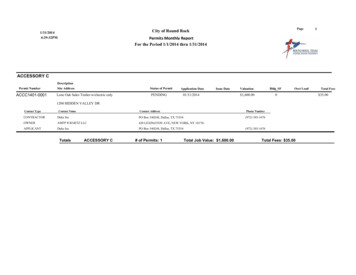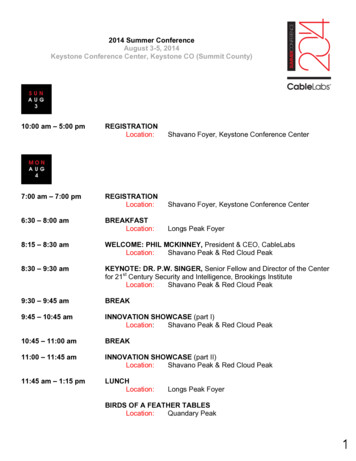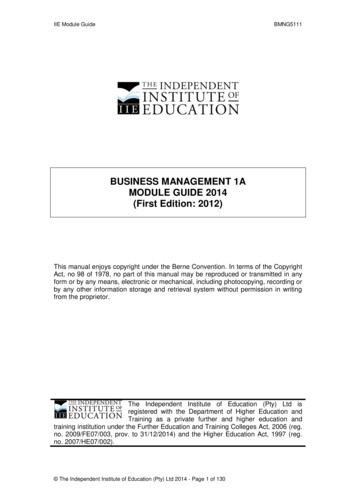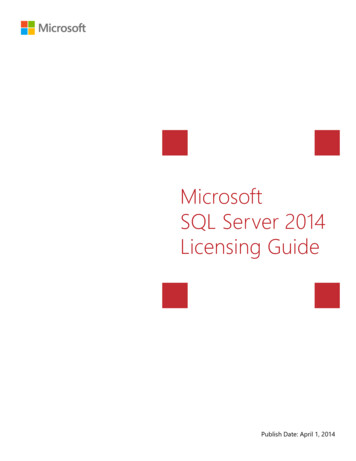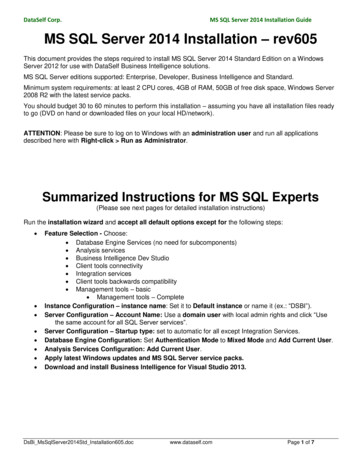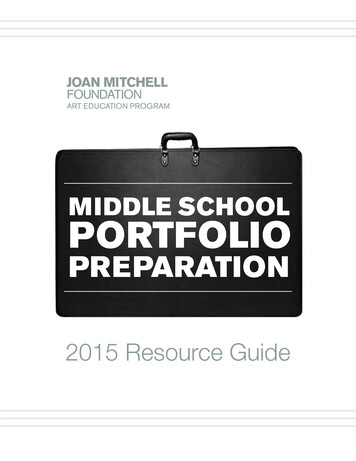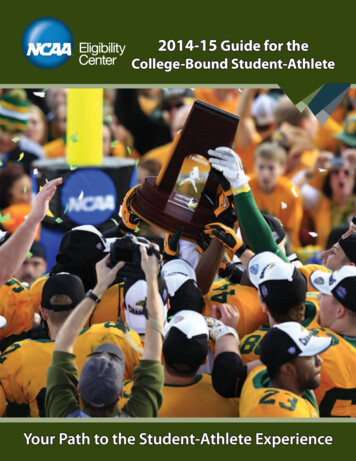
Transcription
2014-15 Guide for theCollege-Bound Student-AthleteYour Path to the Student-Athlete Experience
EVEN IF YOU’RE ASUPERSTAR, THIS IS ONENUMBER YOU WON’T BEABLE TO GET AROUND.But your GPA isn’t the only challenge. If you don’t have the core GPA, thetest scores or the right core courses in high school, you don’t play in college.Don’t let academics hold you back. Check out 2point3.org.
ContentsThe NCAA and NCAA Eligibility CenterContact InformationWelcome from the NCAA Eligibility CenterSteps to Achieving Your EligibilityNCAA Eligibility Center RegistrationFee Waiver EligibilityDivision I Academic Eligibility RequirementsDivision I Sliding ScaleDivision II Academic Eligibility RequirementsDivision II Sliding ScaleDivision III Academic Eligibility RequirementsAre You Prepared?What is a Core Course?Nontraditional CoursesCore-Course Grade-Point AverageDivision I WorksheetDivision II WorksheetTest-Score RequirementsTranscriptsStudents with Documented EIDsThe GEDHome School StudentsInternational StudentsAmateurism Eligibility RequirementsList of NCAA-Sponsored SportsRecruiting RegulationsAthletically Related Financial CAA, NCAA logo and NATIONAL COLLEGIATE ATHLETIC ASSOCIATION areregistered marks of the Association and use in any manner is prohibitedunless prior approval is obtained from the Association.The NCAA does not discriminate against any person regardless ofrace, color, national origin, education-impacting disability, gender, religion,creed, sexual orientation or age with respect to its governance policies,educational programs, activities and employment policies.NOTICEThe information contained in this publication is provided as a service tocollege-bound student-athletes and does not constitute binding advice oncompliance with NCAA rules and bylaws.The NCAA Eligibility Center tries to provide quality information, but becausethis document is provided in an updated electronic form online that issubject to change as needed, the NCAA Eligibility Center makes no claims,promises or guarantees about the accuracy, completeness or adequacy ofthe information contained in this publication.For more information, see eligibilitycenter.org or 2point3.org.
The NCAA and NCAAEligibility CenterHow to use this Guide The Guide addresses issues for four important groups of readers:High school students who hope to participate in collegeathletics at an NCAA Division I or II college or university;Parents and legal guardians;High school counselors and athletics administrators; andScholastic and nonscholastic coaches. What is the NCAA?In addition, if you are sending transcripts or additional informationto the NCAA Eligibility Center or have questions, please use thefollowing contact information.NCAA Eligibility Center Contact InformationNCAA Eligibility Center:Certification ProcessingP.O. Box 7136Indianapolis, IN 46207-7136The NCAA, or National Collegiate Athletic Association, wasestablished in 1906 and serves as the athletics governing bodyfor more than 1,300 colleges, universities, conferences andorganizations. The national office is in Indianapolis, Indiana, but themember colleges and universities develop the rules and guidelinesfor athletics eligibility and athletics competition for each of thethree NCAA divisions. The NCAA is committed to the studentathlete and to governing competition in a fair, safe, inclusive andsportsmanlike manner.Package or overnight delivery:Certification Processing1802 Alonzo Watford Sr. DriveIndianapolis, IN 46202The NCAA membership includes:346 active Division I members;298 active Division II members; and440 active Division III members.NCAA Eligibility Center customer service:U.S. callers (toll free):877/262-1492International callers:317/917-6222Fax:317/968-5100 One of the differences among the three divisions is that collegesand universities in Divisions I and II may offer athletics scholarships,while Division III colleges and universities do not.For more information about the NCAA or its members, please visitNCAA.org.What is the NCAA Eligibility Center?The NCAA Eligibility Center certifies the initial academic eligibilityand amateur status of all college-bound student-athleteswho wish to compete in NCAA Division I or II athletics.To assist with this process, the NCAA Eligibility Center staff is eagerto foster a cooperative environment of education and partnershipwith high schools, high school coaches and college-boundstudent-athletes. Ultimately, the individual student-athlete isresponsible for achieving and protecting his or her eligibility status.How to find answers to your questionsThe answers to most questions can be found in this Guide or by: Accessing the NCAA Eligibility Center's resource page on its website at www.eligibilitycenter.org, clicking on “Resources” andthen selecting the type of student you are (U.S., International orhome school). You can then navigate through the resources tofind helpful information.Contacting the NCAA Eligibility Center at the phone number onthis page.Accessing www.NCAA.org/student-athletes/future for additionalresources.4 COLLEGE-BOUND STUDENT-ATHLETEWeb address:www.eligibilitycenter.orgwww.2point3.org
Dear College-Bound Student-Athlete:This Guide is designed to educate you, your family and high school administrators regardingthe initial-eligibility process for NCAA Divisions I and II colleges and universities. We encourageyou to take an active role in this process, which determines your eligibility to receive an athleticsscholarship, practice and compete in the initial year of full-time enrollment. If you are interestedin Division III, please visit www.ncaa.org/d3 or contact the athletics office at the respectivecollege or university for information regarding initial-eligibility requirements.More than 1,000 NCAA schools offer a variety of academic and athletics programs, so it isnever too early to start doing your homework. Work closely with your high school counselors,coaches, parents/guardians and mentors as you transition to college, which can be a wonderfulexperience academically and athletically.As the “front porch” of the NCAA, the NCAA Eligibility Center strives to make your registrationand certification experience positive and beneficial. Please note the following helpful tips:1. Visit www.eligibilitycenter.org to learn more about opportunities available at NCAA schools.2. Know current and future academic requirements for Division I (2016) and Division II (2018).3. Complete NCAA-approved core courses throughout high school. Your high school counselorcan help.4. Register with the NCAA Eligibility Center during your sophomore year if you are interested inDivision I or II athletics participation.5. After six semesters, send official transcripts from all high schools attended to the NCAAEligibility Center.If you have questions, please contact the NCAA customer service staff at 877/262-1492.Sincerely,NCAA Eligibility CenterCOLLEGE-BOUND STUDENT-ATHLETE 5
classes that match your high school’s List of NCAA Courses.The NCAA Eligibility Center will use only approved corecourses to certify your initial academic eligibility.You can access and print your high school’s List of NCAACourses at www.eligibilitycenter.org. Click the NCAACollege-Bound Student-Athlete link to enter and thennavigate to the “Resources” tab and select “U.S. Students”where you will find the link for the List of NCAA Courses. At the beginning of your sophomore year, complete youronline registration at www.eligibilitycenter.org. If you fall behind, do not take short cuts to recover credits. Eligibility Center code “9999” as a score recipient to sendyour official score(s) directly to the NCAA Eligibility Center.Continue to take college prepratory courses. Double checkto make sure the courses you have taken match yourschool’s List of NCAA Courses.Ask your high school counselor to send an officialtranscript to the NCAA Eligibility Center after completingyour junior year. If you have attended more than onehigh school, the NCAA Eligibility Center will need officialtranscripts from all high schools attended. The NCAAEligibility Center does NOT accept faxed or emailedtranscripts/test scores. However, the NCAA EligibilityCenter accepts transcripts electronically throughParchment, Scrip Safe, ConnectEDU, National TranscriptCenter/Pearson Edustructure, USMO ET and Xap. Before registering for classes for your senior year, checkwith your high school counselor to determine the numberof core courses you need to complete during your senioryear.6 COLLEGE-BOUND STUDENT-ATHLETEEligibility Center will use the best scores from each sectionof the ACT or SAT to determine your best cumulative score.Continue to take college-preparatory courses.Check the courses you have taken to match your school’sList of NCAA Courses.Review your amateurism responses and request finalamateurism certification on or after April 1 (for fallenrollees) or October 1 (for spring enrollees).Continue to work hard to earn the best grades possible. Graduate on time with your graduating class (eightsemesters after starting year nine). After graduation, ask your high school counselor to sendClasses you take must be four-year college preparatoryand meet NCAA requirements to be used for initialacademic eligibility. Register to take the ACT, SAT or both and use the NCAAJuniors Take the ACT and/or SAT again, if necessary. The NCAA Start planning now! Work hard to earn the best grades possible. Most high schools have a List of NCAA Courses. TakeSeniorsFreshman and SophomoresSteps to AchievingYour Eligibility your final official transcript to the NCAA Eligibility Centerwith proof of graduation. The NCAA Eligibility Centeraccepts transcripts electronically through Parchment, ScripSafe, ConnectEDU, National Transcript Center/PearsonEdustructure, USMO ET and Xap.Certifications will only be performed for student-athletesplaced on an NCAA Division I or II institution’s request list.
Fee-Waiver EligibilityNCAA EligibilityCenter RegistrationOnline RegistrationThe NCAA Eligibility Center has designed a website with you,the student-athlete, in mind. This is where you will find the toolsand information you need to begin your college experience as astudent-athlete.To register with the NCAA Eligibility Center, go towww.eligibilitycenter.org and click the link to enter as an NCAACollege-Bound Student-Athlete. To create an account, either clickon the “New Account” button at the top right corner of the screenor the cell phone on the left side of the screen.Note: If you fail to submit all documents required or an NCAAschool does not request your eligibility status, your incomplete filewill be discarded after five years and a new fee will be required ifcertification is requested after that time.Account CreationProvide a valid email address to create an account and begin theregistration process. Be sure you provide an email address thatwill be active even after you complete high school.About MeIn this section, enter some quick facts about your name, address,date of birth and gender.My CourseworkEnter the name and location of the high school you currentlyattend. If you have attended more than one school (includingsummer school) during grades nine, 10, 11 or 12, you will need tohave that information ready as well. List all schools you previouslyattended. Make sure to include all schools, regardless of whetheryou received grades or credits. If you attended ninth grade at ajunior high school located in the same school system in which youlater attended high school, do not list the ninth-grade school. Youmust also include information about whether you took anynontraditional courses, including online or credit recovery.My SportSelect the sport(s) you plan to participate in at an NCAA Division Ior II college or university. The NCAA Eligibility Center will also askabout the nonscholastic and/or club teams you have been on andevents you have participated in during your high school career.PaymentYour account will be eligible for processing once the registrationfee has been paid (or submission of a fee waiver if you have beengranted a waiver). You must pay online by debit, credit card ore-check. Effective September 1, 2014, the registration fee will increaseto 75 for U.S., U.S. Territories and Canadian students (U.S. Territoriesinclude American Samoa, Guam, Northern Mariana Islands, PuertoRico and U.S. Virgin Islands); and 130 for all other internationalstudents.You are eligible for a waiver of the registration fee only if you havealready received a waiver of the SAT or ACT fee (this is not thesame as a U.S. state voucher). You must have an authorized highschool official submit your fee waiver documentation online afteryou have completed your registration. If you have not yet beengranted a fee waiver by SAT or ACT, you are not yet eligible fora waiver of the NCAA Eligibility Center registration fee.As mentioned in the previous section, you are eligible for a waiverof the registration fee only if you have already received a waiverof the SAT or ACT fee (this is not the same as a U.S. state voucher).You must have an authorized high school official submit yourfee waiver documentation online after you have completed yourregistration. If you have not yet been granted a fee waiverby SAT or ACT, you are not yet eligible for a waiver of theregistration fee.Below are the ACT and SAT fee-waiver eligibility requirements.ACTIn order to be eligible for an ACT fee waiver, a student must meetone or more of these indicators of economic need: Family receives low-income public assistance; Student is a ward of the state; Student resides in a foster home; Student is homeless; Student participates in free or reduced-price lunch program atschool; Student participates in federally funded TRIO Program such asUpward Bound; or Family income is at or below the Bureau of Labor Statistics LowStandard Budget.SATYou are eligible for
2014-15 Guide for the College-Bound Student-Athlete Your Path to the Student-Athlete Experience . EVEN IF YOU’RE A SUPERSTAR, THIS IS ONE NUMBER YOU WON’T BE ABLE TO GET AROUND. But your GPA isn’t the only challenge. If you don’t have the core GPA, the test scores or the right core courses in high school, you don’t play in college. Don’t let academics hold you back. Check out .


